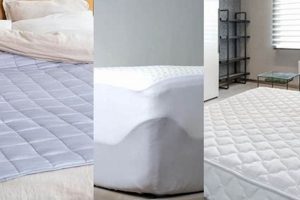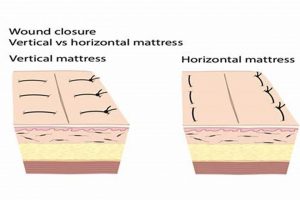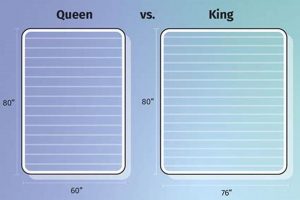The choice between a mattress measuring eight inches and one measuring ten inches in thickness represents a significant decision point for consumers. This selection impacts factors such as comfort, support, and overall bed height. For example, individuals with mobility concerns might find the lower profile of an eight-inch mattress more accessible, while others may prefer the enhanced cushioning potentially offered by a ten-inch model.
The thickness of a mattress directly relates to its ability to provide adequate spinal alignment and pressure relief. Thicker mattresses often incorporate additional layers of comfort materials, which can enhance the sleeping experience. Moreover, mattress thickness can influence the longevity of the product, as thicker models may be more resistant to compression and wear over time. Historically, mattress thickness has evolved in response to advancements in material science and a growing emphasis on ergonomic support.
The following sections will delve into a detailed comparison of mattresses of these two sizes. Discussion will cover the construction materials, support capabilities, suitability for different body types, and price points, ultimately providing the information necessary to make an informed purchasing decision. Factors such as sleeping position and budget constraints will also be considered.
Considerations When Selecting Mattress Thickness
Choosing the correct mattress thickness involves evaluating individual needs and preferences. The following guidelines offer a structured approach to navigating the selection process.
Tip 1: Evaluate Body Weight: Individuals with higher body weights typically require thicker mattresses to ensure adequate support and prevent bottoming out. An eight-inch mattress may be insufficient for individuals exceeding a certain weight threshold, potentially leading to discomfort and reduced mattress lifespan.
Tip 2: Assess Sleeping Position: Side sleepers often benefit from thicker mattresses that provide sufficient cushioning for the shoulders and hips. Stomach sleepers, conversely, may find a firmer, slightly thinner mattress more suitable for maintaining spinal alignment. Back sleepers generally require a medium thickness for optimal support.
Tip 3: Consider Bed Frame Compatibility: Ensure the chosen mattress thickness is compatible with the existing or planned bed frame. A very thick mattress may result in an excessively high bed profile, while a thin mattress may leave an undesirable gap. Measure the bed frame height and account for any headboard considerations.
Tip 4: Research Material Composition: The materials used within a mattress contribute significantly to its overall performance. Denser materials generally offer greater support and durability, regardless of thickness. Inquire about the density of foam layers and the gauge of innerspring coils.
Tip 5: Factor in Budget Constraints: Thicker mattresses often command a higher price point due to the increased material usage. Establish a realistic budget prior to commencing the search and prioritize essential features based on individual needs. Comparing prices across different retailers is recommended.
Tip 6: Account for Partner Preferences: If sharing a bed, consider the preferences of both individuals when selecting mattress thickness. Compromises may be necessary to accommodate differing needs for support and comfort. Dual-sided mattresses or mattresses with adjustable firmness are potential solutions.
Selecting the appropriate mattress thickness is crucial for ensuring long-term comfort and support. These considerations represent a starting point for a more in-depth evaluation process.
The subsequent sections will provide a comprehensive comparison, enabling a well-informed selection.
1. Support
Mattress support, defined as the capacity to maintain spinal alignment and distribute body weight evenly, is directly impacted by thickness. An eight-inch mattress, due to its typically simpler construction and fewer layers, may offer adequate support for lighter individuals or those who prefer a firmer sleeping surface. However, its ability to conform to the body’s contours and prevent pressure points can be limited, potentially leading to discomfort for heavier individuals or those with pre-existing back pain. The reduced depth may also result in increased compression over time, compromising long-term support.
A ten-inch mattress, with its greater thickness, generally incorporates more substantial support cores and additional comfort layers. This construction allows for improved weight distribution and enhanced spinal alignment, particularly for those who require more cushioning. For example, a side sleeper on a ten-inch mattress may experience reduced pressure on their hips and shoulders due to the increased conforming ability of the mattress. Similarly, a heavier individual will likely find the added thickness provides more resistance against sinking, thereby maintaining proper support and preventing lower back pain. The greater material volume also often translates to improved edge support, facilitating easier ingress and egress from the bed.
The relationship between thickness and support necessitates careful consideration of individual needs and body characteristics. While an eight-inch mattress may suffice for certain individuals, the enhanced support offered by a ten-inch mattress is often a worthwhile investment for those seeking optimal spinal alignment and long-term comfort. The decision should be based on a thorough assessment of factors such as body weight, sleeping position, and any existing physical conditions. A mattress failing to provide adequate support can lead to chronic pain and disrupted sleep, underscoring the practical significance of understanding this relationship.
2. Durability
Durability, the capacity of a mattress to maintain its structural integrity and performance characteristics over extended use, is a critical consideration when evaluating eight-inch and ten-inch mattress options. The thickness of a mattress often correlates directly with its longevity, influencing its resistance to sagging, compression, and overall wear and tear.
- Material Density and Quality
Higher density materials, such as memory foam or latex, generally exhibit greater resistance to compression and deformation. A ten-inch mattress often incorporates a higher volume of these durable materials compared to an eight-inch model. This increased material density translates to improved resistance to sagging and a longer lifespan. For example, a ten-inch mattress with high-density foam layers may maintain its original shape and support for several years longer than an eight-inch mattress with lower density foam.
- Construction and Layering
The layering and construction techniques employed in mattress manufacturing directly impact its durability. A ten-inch mattress may feature a more complex layering system with reinforced edges and strategically placed support cores, which enhance its overall structural integrity. This advanced construction reduces the risk of premature sagging or edge collapse. Conversely, an eight-inch mattress with fewer layers and simpler construction may be more susceptible to these issues, particularly under heavy or uneven weight distribution.
- Support Core Resilience
The resilience of the support core, typically composed of innersprings or dense foam, is crucial for maintaining long-term support and preventing bottoming out. A ten-inch mattress allows for a thicker and potentially more robust support core. This enhanced support core provides greater resistance to compression and ensures consistent support over time. For example, a ten-inch innerspring mattress with a higher coil count and thicker gauge wire will generally exhibit superior durability compared to an eight-inch model with a less substantial coil system.
- Cover Material and Stitching
The quality of the mattress cover and the stitching techniques used can also influence durability. A thicker, more durable cover provides protection against wear and tear, while reinforced stitching prevents seams from unraveling. A ten-inch mattress often features a higher-quality cover and more robust stitching compared to an eight-inch model. This enhanced cover and stitching contribute to the mattress’s overall longevity and resistance to damage.
The interplay of these factors highlights the importance of considering durability when choosing between an eight-inch and a ten-inch mattress. While an eight-inch mattress may offer an initial cost advantage, the potential for reduced lifespan and compromised support should be carefully weighed against the long-term value and enhanced durability often associated with a ten-inch mattress. The selection must align with the anticipated usage, individual weight considerations, and the desired lifespan of the product.
3. Comfort Layers
Comfort layers, the uppermost sections of a mattress designed to provide immediate cushioning and pressure relief, represent a key differentiator when comparing eight-inch and ten-inch mattress models. The presence and composition of these layers significantly impact the overall sleeping experience, influencing factors such as contouring, temperature regulation, and perceived firmness.
- Thickness and Material Composition
A ten-inch mattress generally offers greater scope for incorporating thicker and more diverse comfort layers compared to an eight-inch counterpart. This allows for the integration of materials such as memory foam, latex, or gel-infused foams in varying densities and thicknesses. The increased depth can translate to enhanced pressure relief, particularly for individuals with joint pain or pressure sensitivity. Conversely, an eight-inch mattress may feature thinner or fewer comfort layers, potentially resulting in a firmer feel and reduced contouring capability. For example, a ten-inch mattress might include a three-inch layer of memory foam, providing substantial sinkage and conforming to the body’s shape, while an eight-inch model might offer only one inch of similar material, resulting in a less pronounced cradling effect.
- Conforming Ability and Pressure Relief
The ability of comfort layers to conform to the body’s curves and redistribute pressure points is crucial for promoting restful sleep and minimizing discomfort. Thicker comfort layers, typically found in ten-inch mattresses, are better equipped to contour to the body’s unique shape and alleviate pressure on sensitive areas such as the shoulders, hips, and knees. This enhanced conforming ability can be particularly beneficial for side sleepers or individuals with conditions such as arthritis. An eight-inch mattress, with its thinner comfort layers, may provide less targeted pressure relief, potentially leading to increased tossing and turning throughout the night. Individuals seeking maximum pressure relief often find that the increased depth of comfort layers in a ten-inch mattress provides a more satisfactory sleep experience.
- Temperature Regulation
The materials used in comfort layers can also influence temperature regulation, impacting the overall sleeping climate. Certain materials, such as open-cell memory foam or gel-infused foams, are designed to promote airflow and dissipate heat, preventing the buildup of excessive warmth. A ten-inch mattress may incorporate these temperature-regulating materials more effectively due to its increased layer capacity. In contrast, an eight-inch mattress with limited comfort layer thickness may be more prone to trapping heat, potentially leading to discomfort for individuals who sleep hot. The choice of materials and their arrangement within the comfort layers plays a significant role in creating a comfortable and temperature-neutral sleep environment. Breathable materials within comfort layers may enhance the sleeping experience.
- Impact on Overall Firmness
Comfort layers contribute significantly to the perceived firmness of a mattress. The thickness and density of these layers can either soften or stiffen the overall feel of the mattress. A ten-inch mattress with thick, plush comfort layers will generally feel softer than an eight-inch mattress with minimal or firmer comfort layers. The strategic combination of different materials and thicknesses allows manufacturers to fine-tune the firmness level to cater to specific preferences. For example, a ten-inch mattress with a combination of memory foam and a supportive transition layer can provide a balance of plushness and support, while an eight-inch mattress with a thin layer of high-density foam may feel firmer and more supportive. Individual firmness preferences should be carefully considered when evaluating the comfort layers of both mattress types.
The attributes of comfort layers, particularly their thickness, material composition, and impact on pressure relief and temperature regulation, should be thoroughly evaluated when deciding between an eight-inch and ten-inch mattress. These factors directly influence the sleeping experience and contribute to the overall suitability of the mattress for individual needs and preferences.
4. Bed Height
Bed height, measured from the floor to the top surface of the mattress, represents a crucial ergonomic consideration that is directly influenced by the choice between an eight-inch and a ten-inch mattress. This dimension affects accessibility, ease of movement, and overall comfort for individuals getting into and out of bed. The selection should align with physical capabilities and personal preferences to ensure optimal usability and prevent potential strain or discomfort.
- Accessibility and Mobility
The height of the bed significantly impacts accessibility, particularly for individuals with mobility limitations, joint pain, or other physical conditions. A bed that is too low can necessitate excessive bending and strain when getting in and out, while a bed that is too high may require excessive reaching and climbing. An eight-inch mattress, when combined with a standard bed frame, typically results in a lower overall bed height compared to a ten-inch mattress. This lower profile can be advantageous for individuals with shorter stature or those who find it challenging to lift their legs. Conversely, a ten-inch mattress, when paired with a standard bed frame, creates a higher bed height, which may be preferable for taller individuals or those who have difficulty bending. The selection should consider individual physical capabilities and prioritize ease of movement.
- Ergonomic Considerations
Proper bed height promotes optimal spinal alignment and reduces strain on the back and joints. An ergonomically appropriate bed height allows individuals to sit comfortably on the edge of the bed with their feet flat on the floor and their knees at a 90-degree angle. This position minimizes stress on the lower back and facilitates a smooth transition between sitting and standing. The thickness of the mattress contributes directly to achieving this ergonomic ideal. A ten-inch mattress may be necessary to attain the correct bed height for taller individuals, while an eight-inch mattress may be more suitable for shorter individuals. Failing to consider ergonomic factors can lead to discomfort, pain, and potential musculoskeletal issues over time.
- Aesthetic Preferences and Room Proportions
Bed height also plays a role in the overall aesthetic of the bedroom and its perceived proportions. A higher bed can create a more visually dominant focal point, while a lower bed may contribute to a more minimalist and understated design. The choice between an eight-inch and a ten-inch mattress should consider the existing room dimensions and the desired style. In smaller rooms, a lower bed height may create a sense of spaciousness, while in larger rooms, a higher bed height can help to balance the proportions. Visual preferences are subjective, but the impact of bed height on the overall aesthetic should not be overlooked.
- Bed Frame Compatibility
The compatibility of the mattress thickness with the chosen bed frame is a practical consideration that directly affects the final bed height. Certain bed frames are designed for specific mattress thicknesses, and using an incompatible mattress can result in an undesirable bed height. For example, a platform bed with a low profile may not be suitable for a ten-inch mattress, as it could result in an excessively high bed. Conversely, a traditional bed frame with a box spring may require a thicker mattress, such as a ten-inch model, to achieve the desired height. Prior to selecting a mattress, it is essential to consider the dimensions and design of the bed frame to ensure proper compatibility and achieve the intended bed height.
The interplay of these factors underscores the importance of carefully considering bed height when choosing between an eight-inch and a ten-inch mattress. The optimal bed height promotes accessibility, ergonomic comfort, and aesthetic harmony within the bedroom. The selection should be based on individual needs, physical capabilities, and the characteristics of the chosen bed frame.
5. Body Weight
Body weight significantly influences the performance and suitability of a mattress, particularly when distinguishing between eight-inch and ten-inch models. The relationship between body weight and mattress thickness determines the level of support, comfort, and durability experienced by the user. An appropriate mattress selection, based on body weight, is crucial for ensuring proper spinal alignment and pressure relief.
- Support Core Compression
Higher body weights exert greater pressure on the mattress support core, leading to increased compression. An eight-inch mattress, with its typically less robust support system, may exhibit excessive compression under heavier loads, potentially resulting in sagging and compromised spinal alignment. In contrast, a ten-inch mattress often features a more substantial support core designed to withstand greater pressure. This increased resilience prevents premature sagging and ensures consistent support for individuals with higher body weights. The capacity of the support core to resist compression directly impacts the longevity and performance of the mattress.
- Pressure Distribution and Relief
Effective pressure distribution is essential for minimizing discomfort and preventing pressure sores, particularly for individuals who spend extended periods in bed. Thicker mattresses, such as ten-inch models, generally offer superior pressure distribution due to their increased capacity for incorporating comfort layers. These layers conform to the body’s contours, redistributing weight and reducing pressure on sensitive areas such as the hips, shoulders, and back. An eight-inch mattress, with its thinner comfort layers, may provide less effective pressure relief, potentially leading to increased discomfort and disrupted sleep, especially for individuals with higher body weights or pressure sensitivity.
- Edge Support Integrity
Edge support, the ability of the mattress edges to maintain their shape and provide support when sitting or lying near the edge, is often compromised under higher body weights. An eight-inch mattress may exhibit significant edge compression, making it difficult to sit comfortably on the edge and potentially leading to a feeling of rolling off the bed. A ten-inch mattress, particularly those with reinforced edge support systems, provides greater stability and prevents edge collapse, enhancing the usable sleeping surface and facilitating easier ingress and egress. The integrity of the edge support is crucial for maintaining a consistent level of support across the entire mattress surface, regardless of body weight.
- Material Density and Longevity
The density of the materials used in a mattress directly influences its ability to withstand the effects of body weight over time. Higher density foams and innerspring systems are more resistant to compression and deformation, resulting in improved durability and a longer lifespan. A ten-inch mattress typically incorporates higher density materials compared to an eight-inch model, making it better suited for individuals with higher body weights. The increased material density translates to improved resistance to sagging, reduced wear and tear, and a greater overall lifespan, representing a potentially more cost-effective long-term investment.
The interplay of these factors underscores the critical role of body weight in determining the suitability of an eight-inch versus a ten-inch mattress. Selecting a mattress that adequately supports the individual’s weight ensures optimal spinal alignment, pressure relief, and long-term durability, ultimately contributing to a more restful and restorative sleep experience. Ignoring the impact of body weight can lead to discomfort, premature mattress degradation, and potential health issues.
6. Sleeping Position
Sleeping position fundamentally influences the distribution of body weight and pressure points, thereby dictating the ideal mattress thickness for optimal spinal alignment and comfort. The choice between an eight-inch and ten-inch mattress is significantly affected by whether an individual primarily sleeps on their side, back, or stomach.
- Side Sleeping and Contouring
Side sleepers require mattresses that adequately contour to the curves of the body, particularly around the shoulders and hips, to maintain spinal alignment. A ten-inch mattress, with its greater potential for thicker comfort layers, typically offers superior contouring compared to an eight-inch model. The additional thickness allows for deeper compression and more effective pressure relief in these critical areas. An eight-inch mattress may lack sufficient cushioning for side sleepers, potentially leading to pressure points and discomfort. For instance, a side sleeper on an eight-inch mattress might experience shoulder pain due to inadequate sinking and pressure relief. The enhanced contouring capabilities of a ten-inch mattress are often more conducive to the needs of side sleepers.
- Back Sleeping and Support
Back sleepers require mattresses that provide adequate support to the lumbar region, maintaining the natural curvature of the spine. While both eight-inch and ten-inch mattresses can be suitable for back sleepers, the choice depends on individual body weight and firmness preferences. A firmer eight-inch mattress may offer sufficient support for lighter back sleepers, while a ten-inch mattress with a medium-firm feel could provide a more balanced combination of support and comfort for those with higher body weights. The key consideration is ensuring that the mattress prevents the hips from sinking too deeply, which can lead to lower back pain. A back sleeper on a too-soft mattress, regardless of thickness, may experience discomfort. Proper spinal alignment is paramount for back sleepers.
- Stomach Sleeping and Firmness
Stomach sleeping is generally discouraged due to its tendency to promote spinal misalignment. However, if this position is unavoidable, a firmer mattress is recommended to prevent excessive sinking of the midsection. An eight-inch mattress, particularly one with a firm support core, may be more suitable for stomach sleepers than a ten-inch model with softer comfort layers. The goal is to minimize the arching of the back and maintain a relatively neutral spinal posture. A stomach sleeper on a too-soft mattress, particularly a thicker one, may experience lower back pain due to the excessive curvature of the spine. Firmness is the key consideration for stomach sleepers, regardless of mattress thickness.
- Combination Sleeping and Adaptability
Many individuals shift between different sleeping positions throughout the night. For combination sleepers, a mattress that balances support and comfort is essential. A ten-inch mattress with a medium-firm feel and adaptable comfort layers can often accommodate the diverse needs of combination sleepers more effectively than an eight-inch model with limited contouring capability. The ability of the mattress to adapt to different sleeping positions is crucial for minimizing pressure points and maintaining spinal alignment throughout the night. A combination sleeper on an overly firm or soft mattress may experience discomfort or disrupted sleep. Adaptability and balanced support are vital for combination sleepers.
In conclusion, the ideal mattress thickness, specifically the choice between an eight-inch and ten-inch model, is directly linked to the individual’s primary sleeping position. Side sleepers often benefit from the enhanced contouring capabilities of a ten-inch mattress, while back sleepers require adequate lumbar support, which can be achieved with either thickness depending on firmness. Stomach sleepers typically require a firmer mattress, potentially favoring an eight-inch model. Combination sleepers need a mattress that balances support and comfort, often found in a ten-inch model with adaptable comfort layers. Therefore, understanding the relationship between sleeping position and mattress thickness is crucial for selecting a mattress that promotes optimal spinal alignment and restful sleep.
7. Price Point
The financial outlay associated with a mattress represents a primary determinant in consumer purchasing decisions. When comparing an eight-inch versus a ten-inch mattress, a discernible price differential typically exists, stemming from variations in material volume, construction complexity, and potentially, the quality of components. The eight-inch mattress, generally requiring less material and simpler manufacturing processes, often presents a lower initial cost. This lower price point can render it an attractive option for budget-conscious consumers, those furnishing guest rooms, or individuals with short-term bedding needs. For example, a basic queen-size innerspring eight-inch mattress might retail for $300, while a comparable ten-inch model could command a price of $450 or higher. This difference can be significant, influencing the choice irrespective of other factors.
However, a singular focus on the initial price can be a short-sighted approach. While a ten-inch mattress may require a higher upfront investment, its enhanced durability, superior support, and potentially greater comfort layers can translate to a longer lifespan and reduced need for replacement. This extended lifespan can, over time, offset the initial price difference, making the ten-inch mattress a more cost-effective solution in the long run. Furthermore, the quality of sleep and subsequent improvements in overall well-being are difficult to quantify in monetary terms. Investing in a more supportive and comfortable mattress, even at a higher price, may lead to improved health outcomes and reduced expenditures on related healthcare costs. Consider two individuals: one purchases an inexpensive eight-inch mattress that needs replacement within three years, while the other invests in a ten-inch mattress lasting seven years. The initial savings are quickly eroded by the need for a second purchase.
The interaction between price point and mattress thickness necessitates a comprehensive evaluation of individual needs, budget constraints, and long-term value. While an eight-inch mattress can serve as an economically viable option for certain applications, the potential benefits of a ten-inch mattress, including improved durability and enhanced comfort, warrant careful consideration. Consumers should weigh the upfront cost against the anticipated lifespan, potential health benefits, and the overall value proposition before making a final determination. The challenge lies in assessing individual priorities and aligning them with the available budget to make an informed and strategic purchasing decision. Ultimately, the optimal choice depends on the specific circumstances and priorities of the individual consumer.
Frequently Asked Questions
The following addresses common inquiries regarding the selection between eight-inch and ten-inch mattresses, providing objective information to assist in the decision-making process.
Question 1: Is an eight-inch mattress sufficient for all body types?
An eight-inch mattress may provide adequate support for lighter individuals. However, those with higher body weights may require the increased support and durability offered by a ten-inch mattress to prevent sagging and maintain spinal alignment.
Question 2: Does a thicker mattress always equate to greater comfort?
Not necessarily. Comfort depends on the materials used and the construction of the mattress. While a ten-inch mattress allows for more diverse comfort layers, the quality and arrangement of these layers determine the overall comfort level.
Question 3: How does mattress thickness impact temperature regulation?
Thicker mattresses offer more space for incorporating temperature-regulating materials, such as gel-infused foam or open-cell structures. However, temperature regulation also depends on the specific materials used in the comfort layers, regardless of thickness.
Question 4: Can an eight-inch mattress provide adequate support for side sleepers?
An eight-inch mattress may lack sufficient contouring and pressure relief for side sleepers, potentially leading to discomfort. A ten-inch mattress, with its increased comfort layers, is often better suited to accommodate the pressure points associated with this sleeping position.
Question 5: What is the typical lifespan difference between an eight-inch and a ten-inch mattress?
While lifespan depends on usage and material quality, a ten-inch mattress generally exhibits greater durability due to its increased material volume and often more robust construction. This can translate to a longer lifespan compared to an eight-inch model.
Question 6: Does mattress thickness affect the type of bed frame that can be used?
Yes. Bed frame compatibility is crucial. A very thick mattress may result in an excessively high bed profile, while a thin mattress may leave an undesirable gap. Measuring the bed frame height is essential prior to selecting a mattress.
In summary, the selection between an eight-inch and ten-inch mattress necessitates careful consideration of individual needs, body weight, sleeping position, and budget constraints. No single thickness is universally superior; the optimal choice depends on aligning these factors with the characteristics of each mattress type.
The following section will explore alternative considerations regarding mattress selection.
Concluding Remarks
The preceding analysis has explored the critical distinctions between an eight-inch and a ten-inch mattress, emphasizing factors such as support, durability, comfort layers, bed height, body weight considerations, sleeping position suitability, and price point implications. The discussion has highlighted that the optimal choice is not inherently dictated by thickness alone, but rather by a nuanced interplay of individual needs and preferences. Factors such as body weight distribution, primary sleep posture, and budgetary constraints are vital inputs to a decision-making process that must prioritize long-term comfort and spinal health.
Ultimately, the informed consumer must evaluate the discussed criteria against their personal circumstances to determine the most appropriate mattress thickness. A thoughtful assessment of these considerations will promote a sound investment in sleep quality and long-term well-being. Further research into specific mattress materials and construction techniques is encouraged to refine the selection process and ensure a satisfactory purchase.







